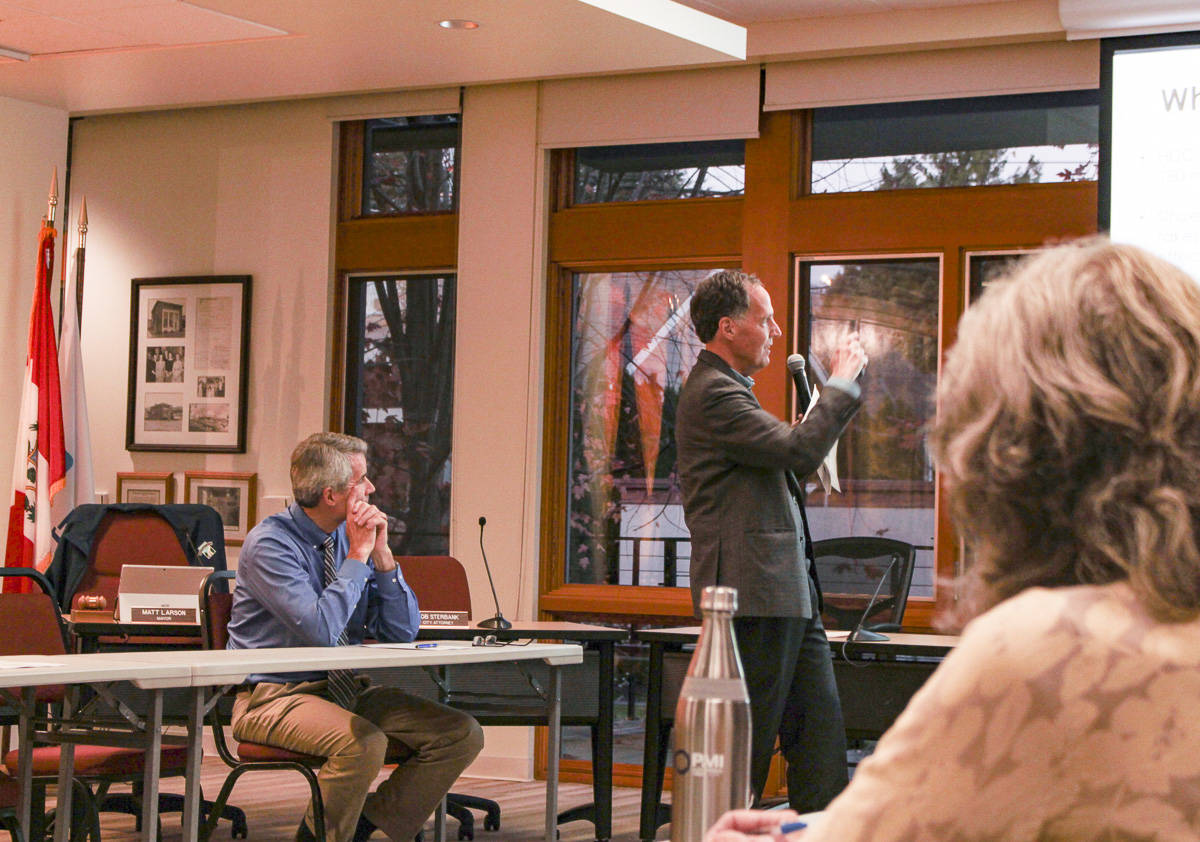Snoqualmie is looking to build new affordable housing policies.
Just before the Oct. 28 council meeting, a presentation was given on affordable housing in a joint meeting of the city council, the planning commission and the economic development commission. The purpose of the round table discussion was to provide an overview of affordable housing policy design.
The presentation included data related to the region’s current affordable housing challenge, a brief overview of available tools and resources that could be utilized to meet the need in Snoqualmie, and some options to explore. The council, city staff and community members asked questions and discussed possible solutions.
Presenters were Marty Kooistra, executive director of Housing Development Consortium, and John Howell, founding partner of Cedar River Group. They shared data about the housing crisis and regional growth in King County.
The presenters defined households spending more than 30 percent of their income on housing expenses as “cost burdened” and those spending more than 50 percent as “severely cost burdened.” Affordable housing is housing that costs less than 30 percent of the household income.
Recent data shows that 75,800 people live in East King County as of 2017. The 2018 census estimates say 13,752 people live in the city of Snoqualmie.
Data from 2015 shows that in King County 45 percent of renters are cost burdened while 29 percent of homeowners are cost burdened. They asserted that many types and sizes of households struggle with housing costs.
Of homeowners in East King County, 19 percent are cost burdened and 9 percent are severely cost burdened. Of renters, 22 percent are cost burdened and 19 percent are severely cost burdened.
“Think about how many people are living in crisis mode,” Kooistra said.
A chart showed that about 290,100 households were cost burdened and about 12,000 people were experiencing homelessness in 2017, with a total estimated need of 156,000 homes.
Taking growth into account, and a projected gain of 88,000 households that will be making 80 percent of the area mean income or lower, the estimated need for homes by 2040 is 244,000.
A couple audience members, including Mayor Matt Larson and Councilmember Sean Sundwall, thought that number seemed high.
Overall, trends show the region has been experiencing immense growth but at the same time a lack of production.
“We haven’t kept up with growth,” Kooistra said. “In King County are there cities in front of this? I would say no.”
They also talked about the trend of rents going up in the region and many people moving to more affordable locations in South King County and commuting to work. But, rent is increasing in those areas, too.
They talked about a few tools communities can leverage and circulated a copy of a recent study by the Housing Development Consortium entitled “Growing Pains: Analyzing Jurisdictional Fragmentation of Affordable Housing Policy in King County” for audience members to flip through. (https://bit.ly/2NeHOkI)
One note they shared from the study, relevant to a community of Snoqualmie’s size, is that cities with populations smaller than 15,000 tend not to have a density bonus, inclusionary zoning, or incentive zoning programs.
They also found that observed local solutions throughout the county mostly fall into the categories of non-regulatory actions, community education and awareness building, development incentives or requirements, and financing.
Within that, a key recommendation is in building partnerships, such as a city joining South King Housing and Homelessness Partners (SKHHP) or A Regional Coalition for Housing (ARCH).
Additionally, it was recommended to build a committee of stakeholders — residents, developers, builders, advocates and community members. Howell and Kooistra said in other communities such a committee has proven to be “essential.”
In beginning to build housing affordability policies in a city, they said it’s important to be clear and purposeful with objectives. The process will result in further policy and budgetary decisions in the future, as well as staffing and potentially hiring an outside consultant.
Keys to success include establishing a broad base of support and setting specific goals for the income levels to be served and the housing types to be produced.
Councilmember Sundwall asked, “What do we do now?”
Howell said that right now there are essentially two main choices: The city can create its own affordable housing strategy through either a community driven or staff driven effort, or it can join a coalition of cities such as ARCH.
He called it a “fork in the road decision,” but said some jurisdictions might consider both options.
Kooistra recommended the city go back to the beginning as if starting from scratch and think about specific goals. While every city is required to set targets, the cities have some control on what their targets will be.
“Be clear about who you want to serve, there are different affordable housing issues for each unique community,” he said.
Councilmember James Mayhew said it is just a starting point.
“This discussion will launch into other discussions,” he said. “The question is — what is the thing that makes the most sense for Snoqualmie? There’s a lot of work to do.”
Washington’s Growth Management Act mandates that city comprehensive plans contain a housing element with certain requirements (https://bit.ly/2oq5Z7w). Comprehensive plans must also align with county and regional policies such as the Puget Sound Regional Council Vision 2050 (https://www.psrc.org/vision).


